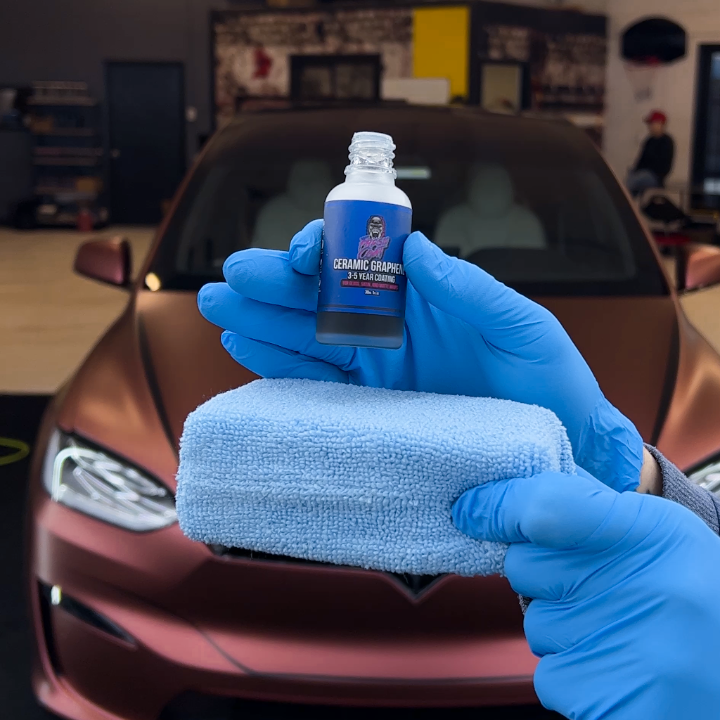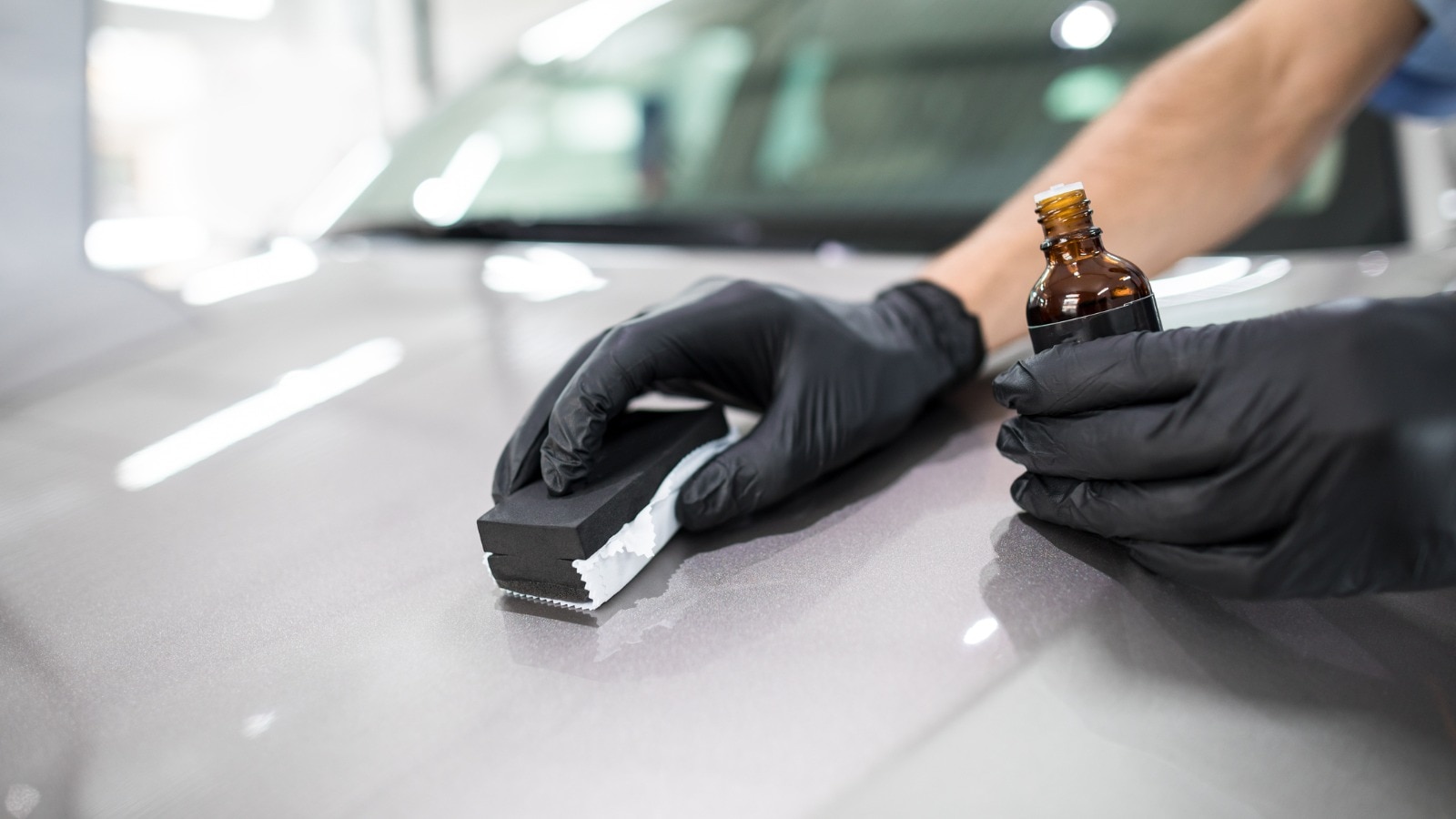The Scientific Research Behind Ceramic Layer: Just How It Boosts Your Automobile's Visual and Durability

Recognizing Ceramic Layer Chemistry
The chemical make-up of ceramic coatings plays a crucial role in establishing their sturdiness and safety residential or commercial properties on car surfaces. Ceramic finishings are typically made up of silicon dioxide (SiO2), which is a key element supplying firmness and heat resistance. Various other components such as titanium dioxide, silicon carbide, and polysilazanes are frequently added to improve details residential or commercial properties like UV resistance, adhesion, and hydrophobicity.
Silicon dioxide, likewise called silica, develops a solid and transparent layer on the car surface when used properly. This layer acts as a guard, securing the paint from environmental impurities, UV rays, oxidation, and chemical stains. Titanium dioxide helps in obstructing hazardous UV rays that can create paint fading and degeneration. Silicon carbide is known for its abrasion resistance, making the ceramic layer durable and challenging against physical damages. Polysilazanes are made use of to enhance the layer's versatility and adhesion to the car's surface area, ensuring resilient protection. Understanding the chemistry behind ceramic layers is critical for both applicators and vehicle owners to appreciate the worth and advantages these coverings use in maintaining the aesthetic charm and durability of lorries.
Improved Gloss and Mirror-like End Up
Understanding the chemical composition of ceramic coverings not only exposes their protective homes however additionally sheds light on how they contribute to achieving an enhanced gloss and mirror-like finish on vehicle surface areas. The trick to the shiny result exists in the nano-ceramic bits existing in the finish. These fragments complete tiny pores and flaws externally, producing a smooth and level coating. As light hits the layered surface area, it mirrors evenly, providing the appearance of a deep, shiny sparkle. In addition, the chemical structure of ceramic finishings allows them to form a solid bond with the automobile's paintwork, stopping oxidation and preserving the clarity of the finish gradually. This bond also withstands environmental pollutants, such as dirt and crud, that can dull the sparkle of the car. The combination of loading buildings, light reflection, and durable security makes ceramic coverings a popular option for those looking for a mirror-like and vibrant surface for their lorries.

Effect On Paint Defense and Durability
Ceramic finishes for vehicles dramatically enhance the durability and security of the paintwork. By creating a chemically immune layer on top of the vehicle's clear coat, ceramic finishes act as an obstacle versus various ecological pollutants that can harm the paint over time.
In terms of durability, ceramic finishes use a long lasting service compared to conventional waxes or sealants. Overall, the protective residential or commercial properties of ceramic finishings contribute substantially to preserving the lorry's paintwork and boosting its aesthetic appeal over an extended duration.
Resistance to Impurities and Rough Components
With the safety guard supplied by ceramic finishings against various ecological pollutants and elements, cars are able to keep their excellent appearance regardless of exposure to rough conditions. Ceramic finishings create a solid barrier that pushes back water, dirt, dirt, and other usual contaminants, preventing them from bonding to the car's surface area. This hydrophobic nature not just makes cleaning less complicated but likewise decreases the risk of water places and etching triggered by acidic impurities. Additionally, the chemical resistance of ceramic coatings helps shield the paint from bird droppings, bug splatter, tree sap, and various other corrosive compounds that can harm the finish gradually.
In addition, ceramic coverings use UV defense, securing the vehicle's paint from the sun's hazardous rays that can trigger fading and oxidation. This resistance to UV damage aids preserve the shade strength and luster of the paint for longer durations. By creating a resilient and sturdy obstacle, ceramic coverings guarantee that the automobile's outside continues to be shielded versus a broad variety of pollutants and severe elements, preserving its aesthetic appeal and durability.
Application Methods and Maintenance Tips
For optimum outcomes when applying ceramic coverings to cars, using proper techniques and sticking to suggested maintenance techniques are necessary. The application process of ceramic covering needs interest to detail and accuracy. Before using the ceramic finish, it is important our website to thoroughly tidy and sanitize the about his automobile's surface to ensure appropriate bond. This involves cleaning, claying, and possibly brightening the paint to create a smooth canvas for the ceramic coating to bond properly.
When using the ceramic finishing, it is recommended to operate in small areas to make certain even insurance coverage and to avoid the item from drying too promptly. Using applicator pads or microfiber fabrics, use the covering in a crisscross or up-and-down movement, depending on the product's directions. After the covering is used, permit it to treat for the defined time before buffing off any type of residue.
In terms of maintenance, routine cleaning with pH-neutral soaps and avoiding extreme chemicals or unpleasant tools will certainly assist maintain the ceramic finishing's stability. Routine evaluations for any type of damages or endure the coating can also assist preserve its safety homes over time.

Conclusion
In verdict, ceramic finishing boosts an automobile's visual charm and resilience through its chemical make-up, offering a shiny finish and securing the paint from environmental pollutants. Its resistance to harsh aspects and convenience of upkeep make it a preferred selection for vehicle proprietors aiming to preserve the look of their vehicles. Overall, ceramic finish is a scientifically backed service for keeping the appearance and longevity of your automobile.
Recognizing the find out this here chemistry behind ceramic coverings is vital for both applicators and vehicle proprietors to value the worth and benefits these finishings supply in maintaining the aesthetic charm and durability of lorries. (ceramic pro)
Recognizing the chemical make-up of ceramic layers not only reveals their protective residential or commercial properties however likewise loses light on just how they add to attaining a boosted gloss and mirror-like finish on vehicle surfaces. By developing a chemically resistant layer on top of the car's clear layer, ceramic finishes act as an obstacle versus numerous ecological contaminants that can damage the paint over time. Generally, the safety buildings of ceramic coverings contribute dramatically to protecting the automobile's paintwork and improving its aesthetic charm over an extended period.
In conclusion, ceramic finishing improves a car's visual allure and longevity via its chemical make-up, supplying a shiny surface and safeguarding the paint from environmental contaminants.